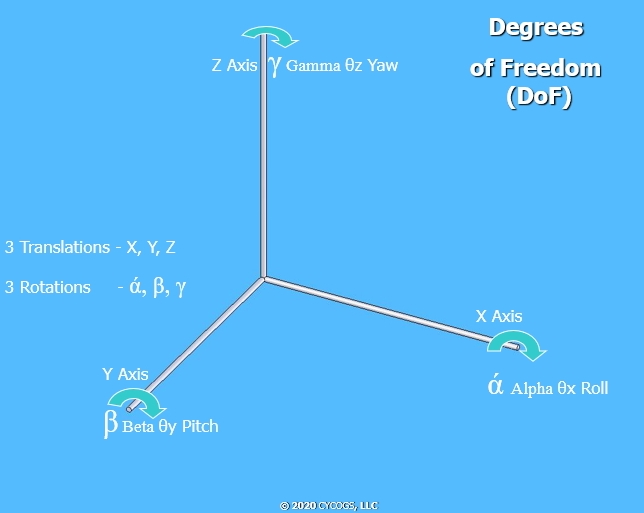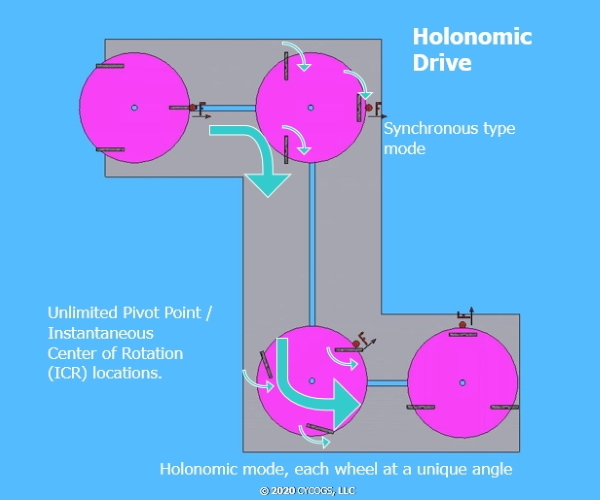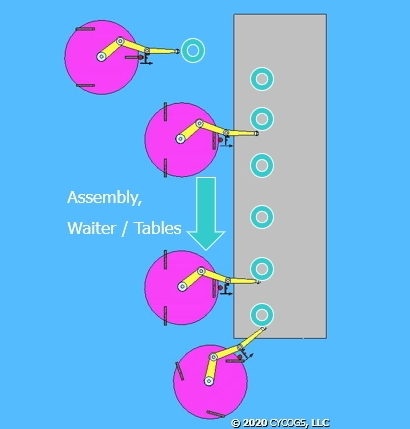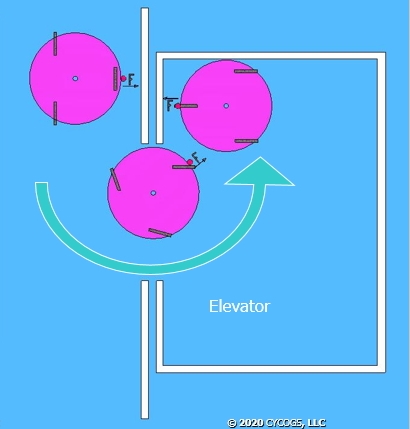Holonomic Mobility Information
The
This is the case for Holonomic Mobility.
Mobile Robotics which operate on a floor or ground usually employ wheels.
Holonomicity refers to a robot’s sum of its Degrees of Freedom (DoF) and the relationship to the controllable Degrees of Freedom. This term is usually applied to robotic arms.
A robot that determines all of its work space Degrees of Freedom (DoF) is said to be Holonomic.
A robot or robotic part with fewer controllable DoF than total workspace DoF is said to be non-holonomic, and a robot with more controllable DoF than total workspace DoF is said to be redundant. Holonomic Redundancy usually has more DoF controllable motions than DoF available in its task or work space. For example, a train can exclusively move on the X axis work space (the train tracks), One - DoF,
and can control its position on that one axis, thus it is holonomic.
Most automobiles can be orientated and move to any position in two - Dimensional (2D) work space.
For example, a train can exclusively move on the X axis work space (the train tracks), One - DoF,
and can control its position on that one axis, thus it is holonomic.
Most automobiles can be orientated and move to any position in two - Dimensional (2D) work space.

The auto requires three - DoF to describe its position (X, Y and gamma),
but at any point, it can move only along the vehicles centerline and turn with a steering angle input. (ignoring skidding and “drifting”) Thus, it has only two control DoF and three positional DoF; therefore, it is non-holonomic.
 This illustration shows a holonomic three wheeled vehicle / robot.
The vehicle or robot is capable of moving in any X – Y – gamma direction or orientation.
The holonomic ability allows for synchronous movements (top of illustration) and performing fully holonomic movements (bottom).
Note how the F = Front orientation changes,
as well as each wheel utilizing its own unique steering angle for a pivot point near the front of the vehicle or robot.
This illustration shows a holonomic three wheeled vehicle / robot.
The vehicle or robot is capable of moving in any X – Y – gamma direction or orientation.
The holonomic ability allows for synchronous movements (top of illustration) and performing fully holonomic movements (bottom).
Note how the F = Front orientation changes,
as well as each wheel utilizing its own unique steering angle for a pivot point near the front of the vehicle or robot.
With holonomic mobility, precise positioning during navigation movements and expanded movements are possible. Now, some holonomic movements are unique. One such unique holonomic movement represents the rotational translating movement, called the
“Frisbee Glide” effect.
 This graphic illustrates the “Frisbee Glide” rotational translating movement.
The robot moves forward in the X axis direction, while rotating on its Z axis.
This graphic illustrates the “Frisbee Glide” rotational translating movement.
The robot moves forward in the X axis direction, while rotating on its Z axis.
Other movement types are possible, using software emulation to move in a Differential mode, a Synchronous move or combinations including other mobility modes.
The ability to simulate a crab, skid or slew movements plus this Holonomic Mobility has the ability to simulate of other drive types like the Ackermann, Differential and Synchronous drives.
This Holonomic Mobility ability allows for precise moves for operating in crowded elevators or hallways. Having holonomic movement abilities eliminates the need for a rotating chassis section with the associated slip ring, and cable tethers design limitations found in Synchronous Mobility Systems, the whole chassis can be rotated by the wheel assemblies. But more software code is involved to take advantage of its increased mobility. The benefits for a holonomic vehicle or robot include economy in movements. Spend a few milliseconds of computer time on some complex trajectory calculations, and save time or conserve energy in making that tricky maneuver. No wasted motion.

Compare this to the non-holonomic robot.
Like performing a tricky move, if even possible for its mobility type could require several minutes of crude maneuvering to position the robot. For environments requiring precise movements, implement a holonomic drive.Learn more about AI Robotics with the
Contact: Send questions and comments about this Education on Holonomic Mobility by